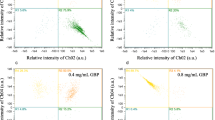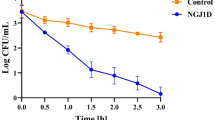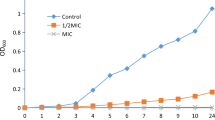Abstract
This paper aims to study the antibacterial action of glycinin basic polypeptide (GBP) on Staphylococcus aureus (S. aureus). Herein, the minimum inhibitory concentration (MIC) of GBP against S. aureus was 0.2 mg/mL. Atomic force microscopy (AFM) imaging showed that GBP seriously damaged the morphology of the S. aureus cells. GBP (0.8 mg/mL) enhanced the relative release of β-galactosidase to 25.48% when compared to the control. The activity of the respiratory-chain dehydrogenase of S. aureus decreased with increasing GBP concentration. GBP could cause a leakage of intracellular substances. Additionally, sodium dodecyl sulfate-polyacrylamide gel electrophoresis (SDS-PAGE) demonstrated that S. aureus bacterial proteins decreased in response to the time period of treating the bacterial cells with GBP. These results indicate that GBP could remarkably inhibit S. aureus and is, therefore, a potential food preservative.
Similar content being viewed by others
References
Carocho M, Barreiro MF, Morales P, Ferreira IC. Adding molecules to food, pros and cons: A review on synthetic and natural food additives. Compr. Rev. Food Sci. F. 13: 377–399 (2014)
Li YQ, Han Q, Feng JL, Tian WL, Mo HZ. Antibacterial characteristics and mechanisms of e-poly-lysine against Escherichia coli and Staphylococcus aureus. Food Control 43: 22–27 (2014)
Gyawali R, Ibrahim SA. Natural products as antimicrobial agents. Food Control 46: 412–429 (2014)
Tang WT, Yuan HN, Zhang H, Wang L, Qian HF, Qi XG. An antimicrobial peptide screened from casein hydrolyzate by Saccharomyces cerevisiae cell membrane affinity method. Food Control 50: 413–422 (2015)
Park CB, Lee JH, Park IY, Kim MS, Kim SC. A novel antimicrobial peptide from the loach, Misgurnus anguillicaudatus. FEBS Lett. 411: 173–178 (1997)
Todorov SD, Wachsman MB, Knoetze H, Meincken M, Dicks LM. An antibacterial and antiviral peptide produced by Enterococcus mundtii ST4V isolated from soya beans. Int. J. Antimicrob. Ag. 25: 508–513 (2005)
Oguro Y, Yamazaki H, Takagi M, Takaku H. Antifungal activity of plant defensin AFP1 in Brassica juncea involves the recognition of the methyl residue in glucosylceramide of target pathogen Candida albicans. Curr. Genet. 60: 89–97 (2014)
Fernandez DI, Le Brun AP, Whitwell TC, Sani MA, James M, Separovic F. The antimicrobial peptide aurein 1.2 disrupts model membranes via the carpet mechanism. Phys. Chem. Chem. Phys. 14: 15739–15751 (2012)
Park SC, Kim JY, Lee JK, Hahm KS, Park Y. Antibacterial action of new antibacterial peptides, Nod1 and Nod2, isolated from Nordotis discus discus. J. Agr. Food Chem. 60: 6875–6881 (2012)
Sung WS, Park Y, Choi CH, Hahm KS, Lee DG. Mode of antibacterial action of a signal peptide, Pep27 from Streptococcus pneumonia, Biochem. Biophys. Res. Co. 363: 806–810 (2007)
Hu SD, Liu H, Qiao SY, He PL, Ma X, Lu WQ. Development of immunoaffinity chromatographic method for isolating glycinin (11S) from soybean proteins. J. Agr. Food Chem. 61: 4406–4410 (2013)
Sitohy MZ, Mahgoub SA, Osman AO. in vitro and in situ antimicrobial action and mechanism of glycinin and its basic subunit. Int. J. Food Microbiol. 154: 19–29 (2012)
Damodaran S, Kinsella JE. Effect of conglycinin on the thermal aggregation of glycinin. J. Agr. Food Chem. 30: 812–817 (1982)
Delwiche SR, Pordesimo LO, Panthee DR, Pantalone VR. Aßsessing glycinin (11S) and ß-conglycinin (7S) fractions of soybean storage protein by nearinfrared spectroscopy. J. Am. Oil Chem. Soc. 84: 1107–1115 (2007)
Mo XQ, Zhong ZK, Wang DH, Sun XZ. Soybean glycinin subunits: characterization of physicochemical and adhesion properties. J. Agr. Food Chem. 54: 7589–7593 (2006)
Osman A, El-Didamony G, Sitohy M, Khalifa M, Enan G. Soybean glycinin basic subunit inhibits methicillin resistant-vancomycin intermediate Staphylococcus aureus (MRSA-VISA) in vitro. Int. J. Appl. Res. Nat. Prod. 9: 17–26 (2016)
Nagano T, Hirotsuka M, Mori H, Kohyama K, Nishinari K. Dynamic viscoelastic study on the gelation of 7S globulin from soybeans. J. Agr. Food Chem. 40: 941–944 (1992)
Ibrahim HR, Sugimoto Y, Aoki T. Ovotransferrin antimicrobial peptide (OTAP-92) kills bacteria through a membrane damage mechanism. Biochim. Biophys. Acta 1523: 196–205 (2000)
Beloti V, Barros MA, de Freitas JC, Nero LA, de Souza JA, Santana EH, Franco BDGM. Frequency of 2,3,5-triphenyltetrazolium chloride (TTC) non-reducing bacteria in pasteurized milk. Rev. Microbiol. 30: 137–140 (1999)
Mohammadzadeh A, Farnia P, Ghazvini K, Behdani M, Rashed T, Ghanaat J. Rapid and low-cost colorimetric method using 2,3,5-triphenyltetrazolium chloride for detection of multidrug-resistant Mycobacterium tuberculosis. J. Med. Microbiol. 55: 1657–1659 (2006)
Zhou QH, Wu ZB, Cheng SP, He F, Fu GP. Enzymatic activities in constructed wetlands and di-n-butyl phthalate (DBP) biodegradation. Soil Biol. Biochem. 37: 1454–1459 (2005)
Klapwuk A, Drent J, Steenvoorden JHAM. A modified procedure for the TTCdehydrogenase test in activated-sludge. Water Res. 8: 121–125 (1974)
Neethirajan S, Di Cicco M. Atomic force microscopy study of the antibacterial effect of fosfomycin on methicillin-resistant Staphylococcus pseudintermedius. Appl. Nanosci. 4: 703–709 (2014)
Nan L, Liu YQ, Lü MQ, Yang K. Study on antibacterial mechanism of copperbearing austenitic antibacterial stainless steel by atomic force microscopy. J. Mater. Sci.-Mater. M. 19: 3057–3062 (2008)
Li A, Lee PY, Ho B, Ding JL, Lim CT. Atomic force microscopy study of the antimicrobial action of Sushi peptides on Gram negative bacteria. Biochim. Biophys. Acta 1768: 411–418 (2007)
Jang SA, Kim H, Lee JY, Shin JR, Kim DJ, Cho JH, Kim SC. Mechanism of action and specificity of antimicrobial peptides designed based on buforin IIb. Peptides 34: 283–289 (2012)
Xing K, Chen XG, Kong M, Liu CS, Cha DS, Park HJ. Effect of oleoyl-chitosan nanoparticles as a novel antibacterial dispersion system on viability, membrane permeability and cell morphology of Escherichia coli and Staphylococcus aureus. Carbohyd. Polym. 76: 17–22 (2009)
Du W, Sun CL, Liang ZQ, Han YF, Yu, JP. Antibacterial activity of hypocrellin A against Staphylococcus aureus. World J. Microb. Biot. 28: 3151–3157 (2012)
Li WR, Xie XB, Shi QS, Duan SS, Ouyang YS, Chen YB. Antibacterial effect of silver nanoparticles on Staphylococcus aureus. Biometals 24: 135–141 (2011)
Haraguchi H, Tanimoto K, Tamura Y, Mizutani K, Kinoshita T. Mode of antibacterial action of retrochalcones from Glycyrrhizainflata. Phytochemistry 48: 125–129 (1998)
Kubo I, Nihei KI, Tsujimoto K. Antibacterial action of anacardic acids against methicillin-resistant Staphylococcus aureus (MRSA). J. Agr. Food Chem. 51: 7624–7628 (2003)
Moosavy MH, Basti AA, Misaghi A, Salehi TZ, Abbasifar R, Mousavi HAE, Alipour M, Razavi NE, Gandomi H, Noori N. Effect of Zataria multiflora Boiss.essential oil and nisin on Salmonella typhimurium and Staphylococcus aureus in a food model system and on the bacterial cell membranes. Food Res. Int. 41: 1050–1057 (2008)
Tang WT, Zhang H, Wang L, Qian HF. Antimicrobial peptide isolated from ovalbumin hydrolysate by immobilized liposome-binding extraction. Eur. Food Res. Technol. 237: 591–600 (2013)
Tang YL, Shi YH, Zhao W, Hao G, Le GW. Discovery of a novel antimicrobial peptide using membrane binding-based approach. Food Control 20: 149–156 (2009)
Author information
Authors and Affiliations
Corresponding author
Rights and permissions
About this article
Cite this article
Yang, J., Sun, GJ., Li, YQ. et al. Antibacterial characteristics of glycinin basic polypeptide against Staphylococcus aureus . Food Sci Biotechnol 25, 1477–1483 (2016). https://doi.org/10.1007/s10068-016-0229-x
Received:
Revised:
Accepted:
Published:
Issue Date:
DOI: https://doi.org/10.1007/s10068-016-0229-x




